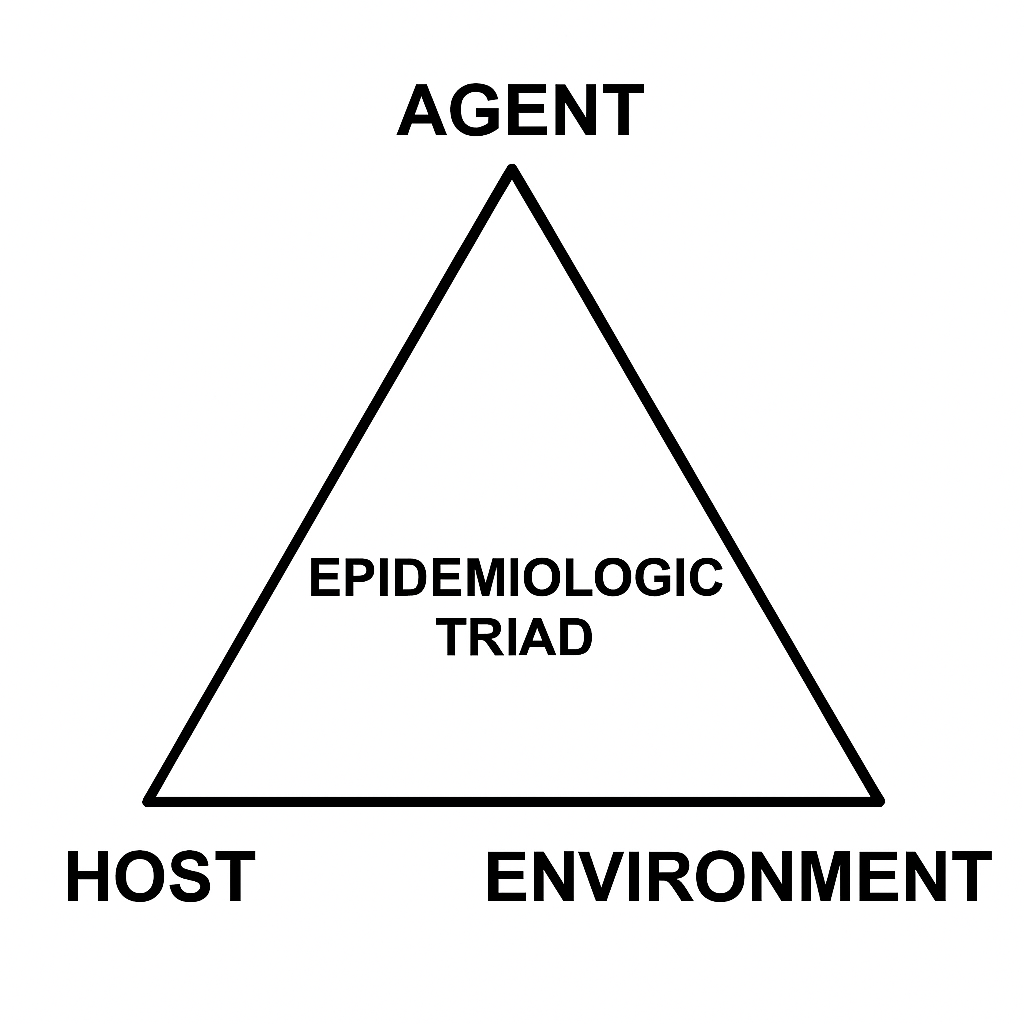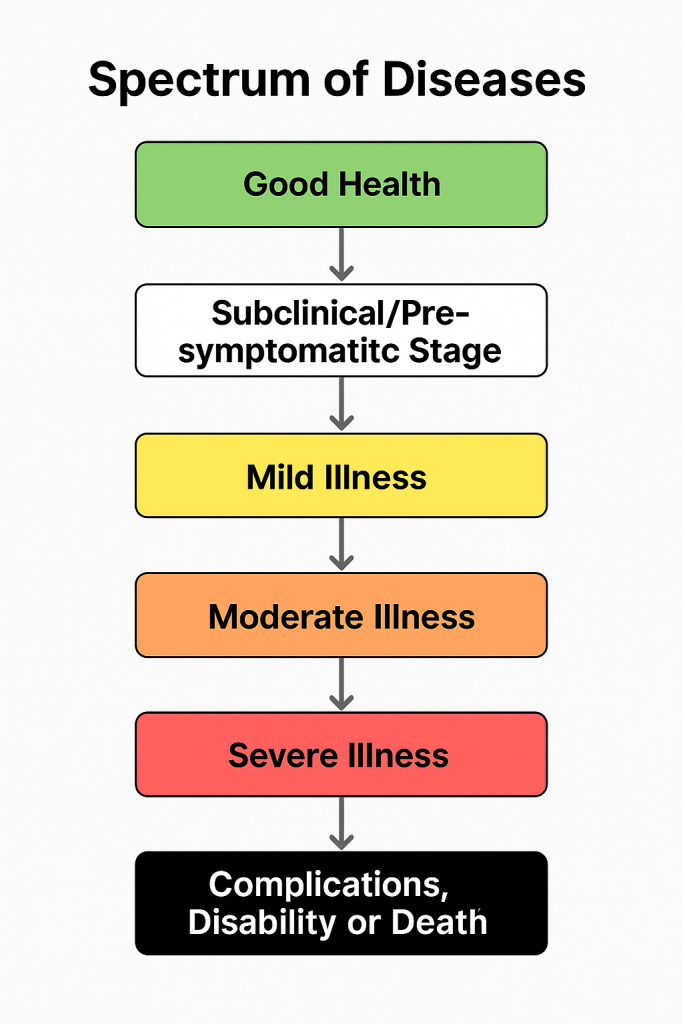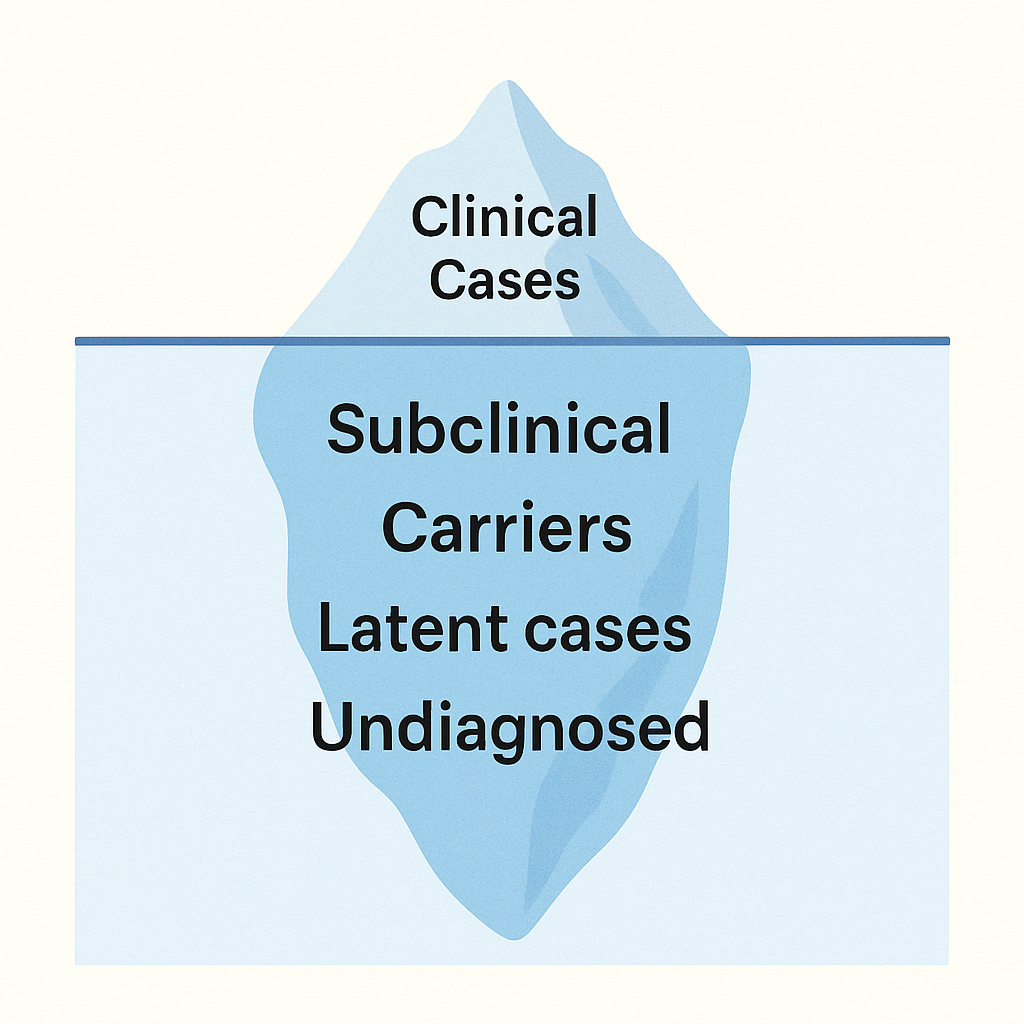CHN-Epidemiology-Synopsis-04-PHC
📚🦠 Important Definitions and Terms Used in Epidemiology
📖 1. Epidemiology
Scientific study of the distribution, determinants, and control of diseases and health conditions in a population.
📖 2. Incidence
Number of new cases of a disease occurring in a defined population during a specified time period.
📖 3. Prevalence
Total number of existing cases (both new and old) of a disease in a population at a given time.
📖 4. Morbidity
Refers to the state of being diseased or unhealthy within a population.
📖 5. Mortality
Refers to the number of deaths due to a disease in a population during a specified period.
📖 6. Epidemic
A sudden increase in the number of cases of a disease above what is normally expected in that population in that area.
📖 7. Endemic
A disease or condition regularly found among particular people or in a certain area.
📖 8. Pandemic
An epidemic that has spread over several countries or continents, usually affecting a large number of people.
📖 9. Sporadic
Diseases that occur infrequently and irregularly.
📖 10. Carrier
A person or animal who harbors an infectious agent without having any signs of the disease but can transmit it to others.
📖 11. Zoonosis
An infectious disease that can be transmitted from animals to humans (e.g., rabies, plague).
📖 12. Incubation Period
Time interval between exposure to infection and the appearance of the first symptoms.
📖 13. Infectivity
The ability of a pathogen to enter, survive, and multiply in the host.
📖 14. Pathogenicity
The ability of a microorganism to cause disease in a host.
📖 15. Virulence
The severity or harmfulness of a disease caused by a pathogen.
📖 16. Reservoir
The natural habitat (human, animal, or environment) where the infectious agent normally lives and multiplies.
📖 17. Vector
A living organism (usually an arthropod like a mosquito) that transmits an infectious agent from one host to another.
📖 18. Fomite
An inanimate object that can carry infectious agents (e.g., clothing, utensils, doorknobs).
📖 19. Surveillance
Continuous, systematic collection, analysis, and interpretation of health data for use in public health planning and action.
📖 20. Attack Rate
The proportion of people who become ill with (or develop) a disease among the total number at risk during an outbreak.
📖 21. Herd Immunity
Resistance of a group to the spread of an infectious disease when a large portion of the population is immune, thereby protecting individuals who are not immune.
🧠 Exam Tips:
- Incidence = New cases; Prevalence = All existing cases
- Endemic = Constant presence; Epidemic = Sudden spike; Pandemic = Global spread
- Carrier = No symptoms but still infectious
- Fomite = Non-living; Vector = Living
- Pathogenicity ≠ Virulence (Pathogenicity = ability to cause disease; Virulence = severity)
📌 Principles of Epidemiology
🔍 Definition
Epidemiology is the scientific study of the distribution, determinants, and control of health-related events or diseases in specified populations.
🎯 Core Principles of Epidemiology
1️⃣ Distribution
- Who? (Person) – age, gender, race, occupation
- Where? (Place) – geographic distribution
- When? (Time) – seasonal trends, epidemics, endemic patterns
2️⃣ Determinants
- Risk factors influencing disease occurrence.
- Examples: lifestyle (smoking), environmental (pollution), biological (genetics), socio-economic (poverty).
3️⃣ Population
- Epidemiology deals with groups or populations, not individuals.
4️⃣ Prevention & Control
- Aim to reduce disease through interventions like vaccination, sanitation, health education.
5️⃣ Quantification
- Use of statistical methods to analyze data for accurate interpretation and planning.
🔖 Key Components of Epidemiological Studies
| 📖 Component | 📝 Explanation |
|---|---|
| 🔎 Agent | Microorganism or factor causing the disease (virus, bacteria, chemical, etc.) |
| 🌍 Host | Human or animal susceptible to disease |
| 🏞️ Environment | External conditions allowing disease transmission (climate, sanitation, crowding) |
🔄 Levels of Disease Occurrence
| 📈 Term | 🧾 Definition |
|---|---|
| 🌎 Endemic | Disease consistently present at expected frequency (e.g., malaria in India) |
| 🌋 Epidemic | Sudden rise of cases beyond expected levels (e.g., dengue outbreaks) |
| 🌐 Pandemic | Global epidemic affecting large populations (e.g., COVID-19) |
| 📉 Sporadic | Occasional, isolated cases without predictable patterns (e.g., plague) |
🛠️ Epidemiological Methods
- ✅ Descriptive: Describe disease occurrence (Who, When, Where)
- ✅ Analytical: Identify factors and determinants (Case-control, Cohort studies)
- ✅ Experimental: Test interventions (Clinical trials)
🎓 Golden Points for Exams
- ✅ Epidemiology = “Study of populations”, not individuals
- ✅ Primary goal: disease prevention & control
- ✅ Epidemiological triad (Agent-Host-Environment) crucial for understanding disease causation
- ✅ Quantitative analysis helps in policy-making and public health actions
- ✅ Endemic ≠ Epidemic ≠ Pandemic
📝 MCQ Snapshot
Q. Which term describes the constant, expected presence of a disease within a geographic area?
- A. Epidemic
✅ B. Endemic - C. Pandemic
- D. Sporadic
Rationale: Endemic refers to the regular, predictable presence of a disease within a particular region.
🔺 Epidemiological Triad (Triangle)

🧠 The Epidemiological Triad is a classical model used to study the cause of disease and how it spreads in a population.
It has three essential components:
1️⃣ Agent 🦠
The cause of the disease
🔹Types of Agents:
| Type | Example |
|---|---|
| 🦠 Biological | Bacteria (TB), Virus (HIV, Influenza) |
| ☢️ Physical | Heat, radiation, cold |
| 🧪 Chemical | Poisons, allergens, pollutants |
| 🧬 Nutritional | Deficiency or excess (e.g., Iron deficiency, obesity) |
| 🧠 Mechanical | Injury, trauma |
2️⃣ Host 🧍
The human or animal that can get the disease
🔹Host Factors:
- Age (👶👴)
- Sex (♂️♀️)
- Immunity (🛡️)
- Genetic makeup 🧬
- Nutritional status 🍎
- Behavior & habits (e.g., smoking 🚬, hygiene 🚿)
🧠 The host’s resistance or susceptibility determines if the disease will occur.
3️⃣ Environment 🌍
External conditions that allow the agent and host to interact
🔹Environmental Factors:
| Type | Examples |
|---|---|
| 🏘️ Physical | Climate, housing, sanitation, pollution |
| 👥 Social | Customs, occupation, poverty, crowding |
| 🏥 Biological | Reservoirs (e.g., animals), vectors (e.g., mosquitoes) |
🧠 Important Notes (High-Yield for Exams):
📌 Disease = Agent + Susceptible Host + Suitable Environment
📌 Removal of any one of the components can prevent disease
📌 Used in both communicable and non-communicable diseases
📌 MCQ-Style Questions:
✅ Q: The classical model of disease causation is known as —
🅰️ Epidemiological Triad
✅ Q: Which component of the triad includes sanitation and climate?
🅰️ Environment
✅ Q: A person with poor immunity is which part of the triad?
🅰️ Host
✅ Q: Bacteria and viruses belong to which part of the triad?
🅰️ Agent
🌈🔍 Spectrum of Diseases

🧠 The spectrum of disease refers to the range of manifestations a disease can exhibit — from no symptoms to severe illness or death.
It helps us understand how a disease behaves in individuals and populations over time.
🧬 Stages in Disease Spectrum
1️⃣ Health 🟢
- Individual is clinically healthy and free of disease
- Example: Normal individual with no exposure or risk
2️⃣ Subclinical Disease (Inapparent) ⚪
- Disease is present, but no symptoms yet
- Only detected by lab or screening tests
✅ Examples:
- Asymptomatic TB infection (Latent TB)
- Incubation period of measles
- Carrier state of Hepatitis B
3️⃣ Clinical Disease (Mild to Severe) 🟡🟠🔴
- Signs and symptoms appear
- Can be classified into:
- Mild illness (e.g., cold)
- Moderate illness (e.g., pneumonia)
- Severe illness (e.g., meningitis, cancer)
4️⃣ Complication/Disability/Death ⚫
- If untreated or severe, disease can cause:
- Chronic disability (e.g., stroke paralysis)
- Organ failure (e.g., kidney failure in diabetes)
- Death (e.g., myocardial infarction)
🧠 Types of Carriers in Subclinical Stage (VERY IMPORTANT❗)
| Type of Carrier | Description | Example |
|---|---|---|
| 🕰️ Incubatory | Before symptoms appear | Polio |
| ♾️ Convalescent | After symptoms disappear | Hepatitis B |
| 👤 Healthy carrier | Never develops disease but spreads it | Typhoid (Mary) |
| 🔁 Temporary/Permanent | Based on duration of carrier state | TB (temporary), HIV (permanent) |
📌 Golden Points for Exams
✅ Disease may range from subclinical → mild → severe → death
✅ Carrier state is part of the subclinical phase
✅ Clinical disease is diagnosable and treatable
✅ Epidemiological triangle (Agent, Host, Environment) affects disease spectrum
📊 MCQ-Style Revision:
✅ Q: A person infected with Hepatitis B but without symptoms is in which stage?
🅰️ Subclinical / Carrier stage
✅ Q: Convalescent carrier means —
🅰️ A person who has recovered from disease but still spreads the infection
✅ Q: Which stage includes signs and symptoms?
🅰️ Clinical stage
✅ Q: Which disease commonly shows healthy carrier state?
🅰️ Typhoid
❄️🌊 Iceberg Phenomenon of Disease

🔍 What is the Iceberg Concept?
🧠 The Iceberg of Disease illustrates that in most diseases, what we see clinically is just a small portion — the tip of the iceberg — while the larger, hidden portion represents subclinical cases, carriers, and undetected infections.
🔼 Tip of the Iceberg (Visible Portion)
- ✅ Clinical cases
- ✅ Symptomatic individuals who seek treatment
- ✅ Easily detectable by health system
🧪 Example:
- TB patient with chronic cough
- COVID-19 patient with high fever & pneumonia
🔽 Submerged (Invisible) Portion
- ⚪ Subclinical infections (no symptoms)
- ⚪ Carriers (infected but not ill)
- ⚪ Latent infections (hidden, inactive)
- ⚪ Undiagnosed/missed cases
🧪 Example:
- Asymptomatic Hepatitis B carrier
- Latent TB infection
- Mild COVID-19 with no testing
📘 Examples of Diseases with Iceberg Pattern
| Disease | Clinical Cases | Subclinical/Carriers |
|---|---|---|
| Poliomyelitis | 1% | 99% subclinical |
| Tuberculosis | Few | Many latent & undiagnosed |
| COVID-19 | Moderate | High asymptomatic load |
| Hepatitis B | Low visible | High healthy carriers |
| HIV (Early stage) | Often missed | Detected late unless tested |
📌 Golden Key Points for Exams
✅ Coined by: J.N. Morris
✅ Used in: Communicable diseases mostly
✅ Significance: True burden of disease is underestimated
✅ Implication: Public health measures must consider hidden cases
🧠 MCQ Style Revision
✅ Q: The iceberg phenomenon is seen in —
🅰️ Communicable diseases
✅ Q: The tip of the iceberg represents —
🅰️ Clinical cases
✅ Q: Majority of cases in iceberg model are —
🅰️ Subclinical or undiagnosed
✅ Q: Iceberg phenomenon was proposed by —
🅰️ J.N. Morris
🦠📚 Concept of Disease Control
🧠 “To limit the spread of disease and reduce its impact on public health.”
🔍 Definition
👉 Disease control refers to all public health efforts and measures aimed at:
- Reducing the incidence, prevalence, morbidity, or mortality of a disease
- Limiting its spread within a community or population
🧩 Key Objectives
| 🎯 Objective | 📌 Description |
|---|---|
| 🔺 Reduce Incidence | Lower the number of new cases |
| 🔽 Reduce Prevalence | Minimize total number of existing cases |
| ⚕️ Limit Morbidity | Reduce illness and its complications |
| 💀 Decrease Mortality | Prevent deaths caused by the disease |
| 🔒 Break Chain of Transmission | Identify & block disease transmission routes |
🧬 Types of Disease Control
| Type | Explanation |
|---|---|
| Control | Disease is present but measures keep it at manageable level |
| Elimination | No new cases in a defined area, but continued prevention is needed |
| Eradication | Worldwide total elimination of the disease (e.g., smallpox) |
🧰 Methods of Disease Control
| 🧩 Category | 📌 Examples |
|---|---|
| 🔄 Interrupt Transmission | Isolation, quarantine, vector control, sanitation |
| 💉 Vaccination | Immunization programs (e.g., polio, measles) |
| 🏥 Early Diagnosis & Rx | Screening, early treatment, contact tracing |
| 📚 Health Education | Promoting hygiene, awareness campaigns |
| 🧼 Environmental Control | Clean water, proper sewage, vector control |
🌐 Examples in Public Health
- ✅ TB control using DOTS (Directly Observed Treatment)
- ✅ Malaria control via mosquito nets & insecticides
- ✅ COVID-19 control through vaccines, masking, distancing
📉 Measurable Indicators of Control
| 📊 Indicator | 🧾 Example |
|---|---|
| 🔺 Incidence Rate | ↓ Number of new cases/year |
| 🏥 Hospitalization Rate | ↓ Number of admitted cases |
| 💀 Case Fatality Rate | ↓ Deaths among diagnosed patients |
| 💉 Immunization Coverage | % of population vaccinated |
🧠 💡 Golden Points for Exams
- ✅ Disease control ≠ Disease elimination
- ✅ Control can be local, regional, or global
- ✅ Health education is a preventive control strategy
- ✅ Control measures vary based on mode of transmission
- ✅ Surveillance is key to monitor & guide control measures
📝 MCQ Snapshot
Q. What is the primary goal of disease control?
A. Increase case detection
B. Eliminate all diseases
✅ C. Reduce the occurrence and impact of disease
D. Provide medicines free of cost
Rationale: The main aim of disease control is to minimize disease occurrence and reduce burden through various health interventions.